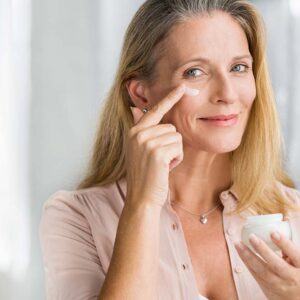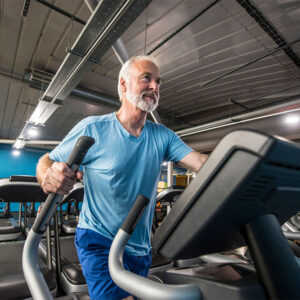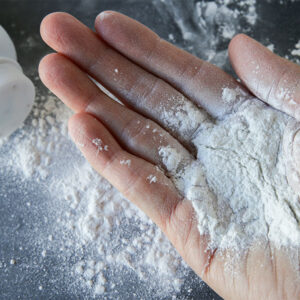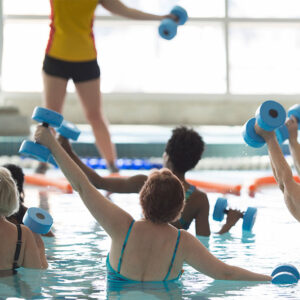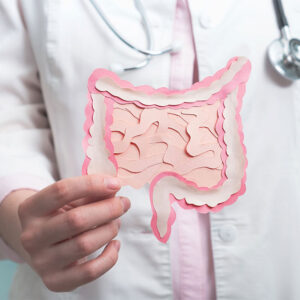
The Common Kitchen Appliance That’s Destroying Your Health
- Your #1 source of antioxidants may also be causing man-boobs
- This popular kitchen convenience doubles your dose of synthetics
- One easy way to brew your antioxidants without added hormones
Dear Reader,
For most of us, the day doesn’t start until after the first cup of coffee.
And with good reason, coffee drinkers enjoy many health benefits from their morning brew.
However, there is a major health problem lurking in the most popular types of coffee brewing systems: flame retardants and estrogenic chemicals.
This nasty brew of synthetics can lead to issues such as obesity, Type 2 diabetes, and, even worse, reproductive disorders like man-boobs.
Today, we will share with you a way to brew healthy coffee without the added harm.
But first, let’s discuss the important health benefits of your morning routine… and how it could be doing more harm than good…
The Good and Bad of Your Morning Joe
Fully 54% of Americans over the age of 18 drink coffee every day.
And not just a cup of daily coffee, but 3.1 cups of it.1
More importantly, a study shows that American’s get more antioxidants from coffee than any other source — including fruits and vegetables. Due to the antioxidants in coffee’s easy absorption by the body, both decaffeinated and regular coffee provide a powerful source for regular drinkers .2
Beyond providing these cell-protective antioxidants, a study found drinking coffee can reduce your risk of developing Type 2 diabetes by 50 percent for those who drink four or more cups a day. 3
And the good news about coffee doesn’t stop there. There is research indicating coffee to have all sorts of health benefits ranging from making you happier to preventing liver cirrhosis.4
With all of these amazing health properties, plus the added caffeine boost, it seems that coffee is a no-brainer for those of us needing a little help in the mornings.
But there is some bad news — the toxins found in your coffee maker might overshadow all of the healthy benefits of your coffee.
Most automatic coffee makers have plastic brewing components. Since these plastic parts contain health-hazardous chemicals, they might be turning your daily joe from a healthful brew into a toxic swill.
However, there are healthy and plastic-free ways to get your coffee in and keep the toxins out. I will share a few helpful tips in a bit.
First, let’s get to the bottom of your coffee maker.
One Toxin With Your Coffee or Two?
If you have ever bought a new coffee maker, then you will likely remember those nasty first five–10 pots of coffee. You know, the ones that taste like Saran Wrap with a mild hint of coffee.
While the subsequent pots taste more like coffee and less like what your lunch is wrapped in, the plastic taste never totally goes away.
Regardless of its potent synthetic taste, the automatic coffee maker remains the cornerstone of many kitchens, offices, and break rooms.
In fact, I have already seen seven in the course of my day.
While these common little machines make our lives easier, they may also be slowly poisoning us with neurotoxic substances and estrogen-like chemicals.
Many plastic-based coffee makers contain endocrine-disrupting chemicals (EDCs) such as polybrominated diphenyl ethers (PBDEs), a flame-retardant substance used in molded plastics, and Bisphenol A (BPA), a common plastic additive.
These flame-retardant substances in plastics can store in human fat cells and has been detected in human blood, tissues, and breast milk. They can also cause neurological, reproductive, and thyroid issues in animals.5
For many years, BPA a plastic additive, has been known to affect fetuses and reproductive organs in humans and animals. More recently, a study has found that the endocrine-disrupting powers of BPA may lead to Type 2 diabetes.
Both of these synthetics are dangerous to humans because they interfere with the body’s natural hormone functions and can cause serious health issues.
Sometimes referred to as “gender-bending chemicals,” they lower the male hormone testosterone and boost the female hormone estrogen. For men, this means reduced virility and feminization of features, such as an increased growth of breast tissue, aka “man-boobs.” For women, this means riskier pregnancies and possible long-term issues with reproductive organs.
Andrea C. Gore, chair of the Endocrine Society task force and a pharmacologist at the University of Texas at Austin, reports:
The evidence is more definitive than ever before — EDCs disrupt hormones in a manner that harms human health. Hundreds of studies are pointing to the same conclusion, whether they are long-term epidemiological studies in human, basic research in animals and cells, or research into groups of people with known occupational exposure to specific chemicals.6
The jury is still out (for the moment, anyways) on whether PBDEs and BPA are carcinogens, but it would makes sense that if they are able to interrupt important bodily functions, they can probably cause cancer.
Beyond the nasty taste, there’s real danger in heating up those plastic parts. Boiling water speeds up the leaching process for many harmful plastic additives, including BPA.
In fact, BPA leaches out 55 times faster when exposed to hot liquids than in normal circumstances, meaning you are getting 55 times more of it with every sip of a hot beverage verses a room-temperature one.7
And to make things worse, the wildly popular single-serving coffee pod machines (like Keurig’s) may be the worst of the lot when it comes to leaching. Made almost entirely of plastic, the water reservoir provides the perfect space for chemicals to leach into the brewing water.
Hands down, the worst part of these machines are the pods (K-cups) themselves.
You know, these guys:
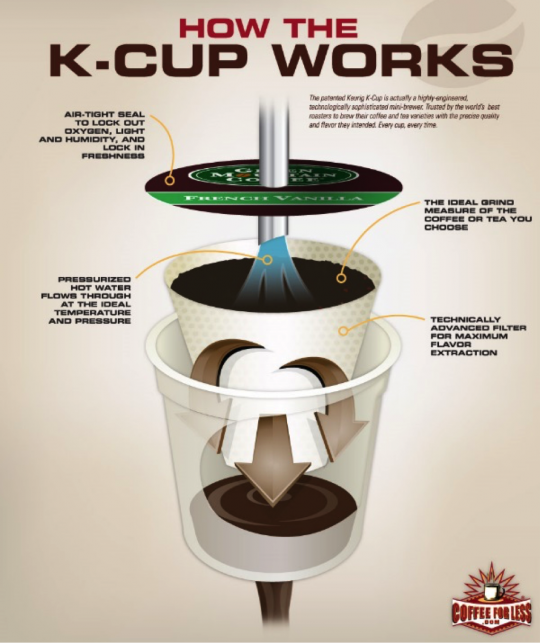
Photo credit: Dailytech.com
The above graphic is supposed to show you all of the benefits of the K-cup system. In reality, it shows you how hot water is plunging through yet another layer of plastic before it makes it to your cup.
And it’s the worst kind of plastic: No. 7.
No. 7 is a blend of plastics and considered to be in the “other” category of plastic types and is not recyclable.
While Keurig says these No. 7 pods are BPA-safe, the real trouble is there is new evidence that even BPA-free plastics can have estrogenic effects.
These machines are double trouble on your health. Not only are you getting a dose of toxins from the machine, but you’re now getting a bonus exposure from the hot water shooting through the pods.
So when you add all of these factors together, it looks your plastic-based automatic coffee maker is delivering you a morning cup of foul-tasting, health-ruining toxins.
And the worst part is these chemicals may be diluting coffee’s natural health benefits!
But it doesn’t have to be this way. There are several ways to make your morning brew and skip the synthetics.
Today, I will share with you a variety of plastic-free coffee makers, as well as my preferred brewing method.
Let’s dive in!
Choose a Healthy Brew
Many producers of kitchen products are now advertising as BPA-free. While buying a new BPA-free plastic automatic coffee maker may seem to be the easiest solution, it is not the safest.
Chances are even the BPA-free containers will still contain flame-retardants or other synthetics.
Your best bets are nonplastic coffee makers like French presses, percolators, and pour-overs.
French presses and percolators are some of the most flavorful ways to brew coffee without plastic parts. These methods don’t use filters, so your brew contains all of the coffee’s natural oils, enhancing the flavor.
However, studies have shown this may not be the most optimal method if you have high cholesterol. Coffee oils contain cafestol. Cafestol can increase overall levels of cholesterol, LDL cholesterol, and triglycerides.10 Most experts agree the occasional French press cup of coffee is perfectly safe, but you may not want to make it your daily coffee.
Your best option is to use a pour-over coffee system, as it uses a filter and is typically made of porcelain or glass.
The Hario V60 is an easy-to-use pour-over and is available without plastic components.
Click here for more information on the V60 and here for filters.
No matter your method, it’s important to use organic coffee and an unbleached paper filter every time you brew to reduce chemical exposures.
If you have a plastic-free coffee method you want to share, please do! nmoore@lfb.org
Live well,

Natalie Moore
Managing editor, Living Well Daily
P.S. Ordering drip coffee from a cafe isn’t necessarily a healthier option. As a former barista, I can attest that several commercial brewers have plastic parts. Not to mention the added exposure from plastic-lined cups and plastic lids, stirrers, and straws. However, many cafes offer pour-over or French press options.
Sources
[2] Coffee is number one source of antioxidants
[3] Why coffee drinking reduces the risk of Type 2 diabetes
[4] 11 Reasons You Should Drink Coffee Every Day
[5] Technical Fact Sheet – Polybrominated Diphenyl Ethers (PBDEs) and Polybrominated Biphenyls (PBBs)
[6] BPA exposure has been linked to an increase in diabetes and obesity
[7] Plastic (Not) Fantastic: Food Containers Leach a Potentially Harmful Chemical
[8] Your Coffee Pods’ Dirty Secret
[9] Styrene
[10] Does Coffee Raise Cholesterol?
Written By Natalie Moore
Natalie Moore is a dedicated health researcher with a passion for finding healthy, natural, and science-based solutions. After a decade of direct healthcare experience in western and natural medicine, she was involved in public health research before joining Living Well Daily.
View More Free Articles
The Secret Ingredient to a Longer, Happier Life
Let’s face it. We’re all in need of an attitude adjustment from time to time. After all, when you turn on the news these days, the world can seem pretty dark. That is unless you make it a practice to look for the silver linings. In fact, Harvard researchers say when you do, something quite...
Do You REALLY Need All Those Skincare Products?
I often get questions about skincare products—and here’s what I’ve learned. In today’s beauty-obsessed world, it’s easy to fall into the trap of spending hundreds every month believing you need countless products to fight aging and achieve healthy, glowing skin. However, many dermatologists argue that LESS is MORE when it comes to skincare. Simplifying your...
“Ebb and Flow” Technique TRANSFORMS Senior Brain Health
You know by now that exercise is good for you. It keeps your heart healthy, your muscles strong, and your waistline trim. But what if I told you that a trendy “ebb and flow” workout technique—often associated with young fitness enthusiasts—could actually be a game-changer for us “oldsters” when it comes to brain health? And...
Mailbag: Slash Your Risk of Bone Fractures as You Age
“My doctor recently told me that I have osteoporosis. What can I do to reduce my risk of fractures and maintain strong bones as I age?” – Margaret Hi Margaret, Sorry to hear about your diagnosis. I’m sure it was a shock. Osteoporosis is a serious condition that affects millions of people, and it’s not...
Household Favorite EXPOSED as Cancer Risk?
We all want to believe that the products we use daily are safe. After all, if they weren’t, they wouldn’t be on store shelves, right? Well, I hate to break it to you, but sometimes, the truth is far more alarming than we’d like to admit. The World Health Organization (WHO) has just dropped a...
Hidden Heatwave Threat REVEALED
Heat waves can have serious consequences. After all, staying cool isn’t just a comfort issue. When the mercury soars, it threatens your health—especially when you’re a senior. There are various reasons for this, including chronic medical conditions and bodies that just don’t regulate temperature as well as they once did. But there’s another heat-linked threat...
The Hidden Threat Behind Your Achy Joints
Picture this… You’re trying to enjoy a leisurely stroll in the park, but each step sends a jolt of pain through your knee. Or maybe you’re attempting to open a stubborn jar lid, only to have your fingers refuse to cooperate, leaving you feeling frustrated and helpless. Perhaps you’re simply trying to get out of...
Parkinson's Signs You Can't Afford to Miss
Imagine waking up one day to find your body betraying you. Your hands tremble as you try to button your shirt. Your feet shuffle when you want to walk with purpose. Once strong and clear, your voice now barely reaches above a whisper. This is the reality for those living with Parkinson’s. But what if...
Do Protein Needs Drop with Age? The SURPRISING Answer
I had a patient ask me the other day if they needed as much protein now as when they were younger. After all, we aren’t quite as active as seniors compared to when we were spring chickens. It’s a good question. And the answer might surprise you… Remember when you could devour a whole pizza...
Follow Your “Gut Feeling” to Reduce Diabetes Risk
It seems like every day we learn something new about the incredible influence our gut has on our overall health. From mood to immunity, and even to how well we sleep, the community of microbes in our digestive tract is pulling the strings behind the scenes. So, it should come as no surprise that researchers...

